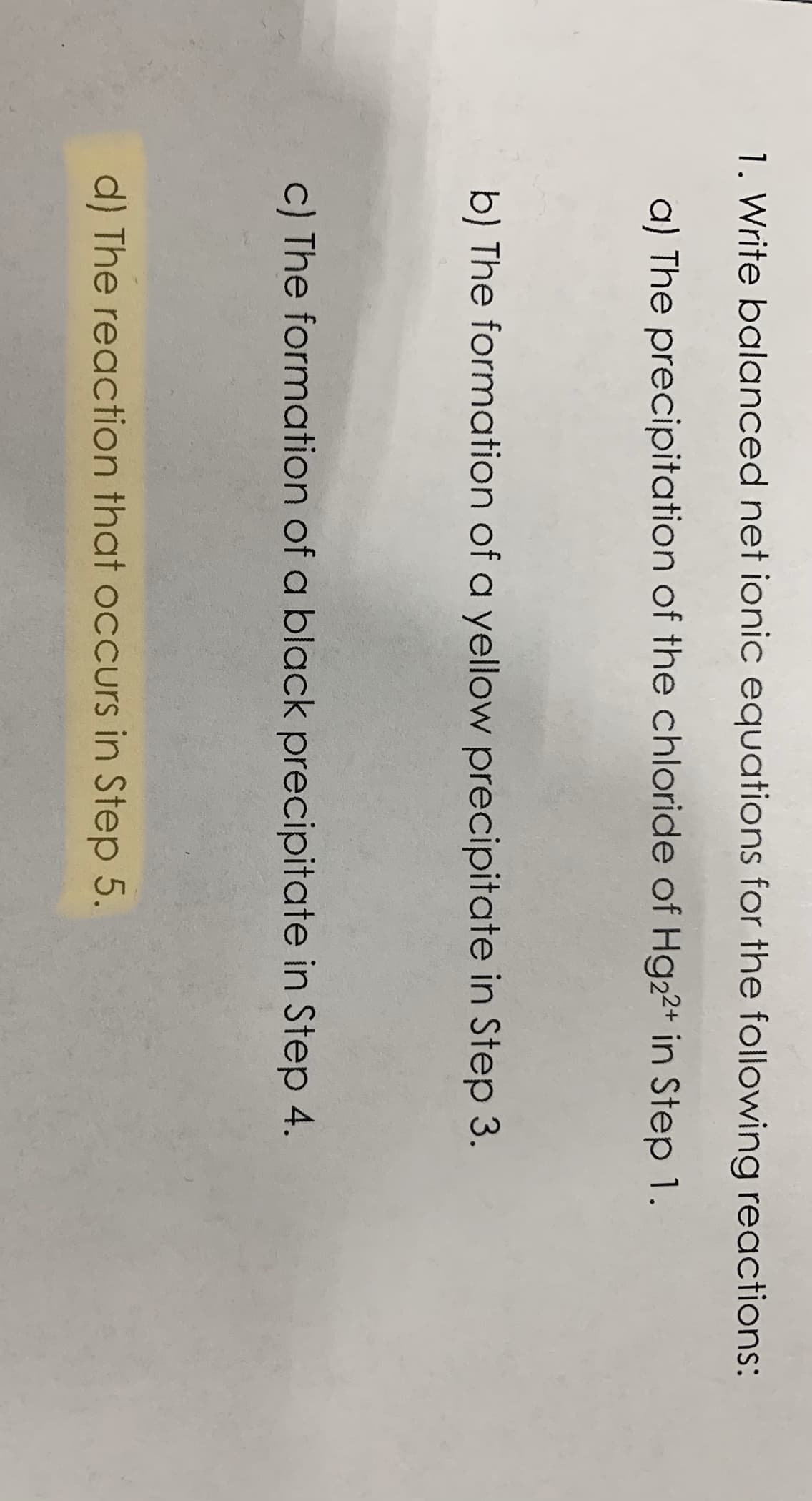1. Write balanced net ionic equations for the following reactions: a) The precipitation of the chloride of Hg22+ in Step 1. b) The formation of a yellow precipitate in Step 3. c) The formation of a black precipitate in Step 4. d) The reaction that occurs in Step 5. Step 5: Identification of Ag*. Soh Add 6 M HNO3 to the test tube containing the solution saved in Step 4 until it is acidic. It will take approximately 1 ml. Test for acidity by dipping the end of a glass stirring rod into the solution and then touching it to blue litmus paper. The litmus paper will turn red if the solution is acidic. The formation of a white precipitate (AgCl) indicates the presence of Ag+ ions.
1. Write balanced net ionic equations for the following reactions: a) The precipitation of the chloride of Hg22+ in Step 1. b) The formation of a yellow precipitate in Step 3. c) The formation of a black precipitate in Step 4. d) The reaction that occurs in Step 5. Step 5: Identification of Ag*. Soh Add 6 M HNO3 to the test tube containing the solution saved in Step 4 until it is acidic. It will take approximately 1 ml. Test for acidity by dipping the end of a glass stirring rod into the solution and then touching it to blue litmus paper. The litmus paper will turn red if the solution is acidic. The formation of a white precipitate (AgCl) indicates the presence of Ag+ ions.
Chemistry: Principles and Practice
3rd Edition
ISBN:9780534420123
Author:Daniel L. Reger, Scott R. Goode, David W. Ball, Edward Mercer
Publisher:Daniel L. Reger, Scott R. Goode, David W. Ball, Edward Mercer
Chapter4: Chemical Reactions In Solution
Section: Chapter Questions
Problem 4.10QE: Draw the flow diagram for a calculation that illustrates how to use a titration to determine the...
Related questions
Question
Balanced net ionic equation of d)

Transcribed Image Text:1. Write balanced net ionic equations for the following reactions:
a) The precipitation of the chloride of Hg22+ in Step 1.
b) The formation of a yellow precipitate in Step 3.
c) The formation of a black precipitate in Step 4.
d) The reaction that occurs in Step 5.

Transcribed Image Text:Step 5: Identification of Ag*.
Soh
Add 6 M HNO3 to the test tube containing the solution saved in Step 4 until it is acidic. It will take
approximately 1 ml. Test for acidity by dipping the end of a glass stirring rod into the solution and
then touching it to blue litmus paper. The litmus paper will turn red if the solution is acidic. The
formation of a white precipitate (AgCl) indicates the presence of Ag+ ions.
Expert Solution
This question has been solved!
Explore an expertly crafted, step-by-step solution for a thorough understanding of key concepts.
This is a popular solution!
Trending now
This is a popular solution!
Step by step
Solved in 2 steps with 1 images

Knowledge Booster
Learn more about
Need a deep-dive on the concept behind this application? Look no further. Learn more about this topic, chemistry and related others by exploring similar questions and additional content below.Recommended textbooks for you

Chemistry: Principles and Practice
Chemistry
ISBN:
9780534420123
Author:
Daniel L. Reger, Scott R. Goode, David W. Ball, Edward Mercer
Publisher:
Cengage Learning

Chemistry: Principles and Reactions
Chemistry
ISBN:
9781305079373
Author:
William L. Masterton, Cecile N. Hurley
Publisher:
Cengage Learning

General Chemistry - Standalone book (MindTap Cour…
Chemistry
ISBN:
9781305580343
Author:
Steven D. Gammon, Ebbing, Darrell Ebbing, Steven D., Darrell; Gammon, Darrell Ebbing; Steven D. Gammon, Darrell D.; Gammon, Ebbing; Steven D. Gammon; Darrell
Publisher:
Cengage Learning

Chemistry: Principles and Practice
Chemistry
ISBN:
9780534420123
Author:
Daniel L. Reger, Scott R. Goode, David W. Ball, Edward Mercer
Publisher:
Cengage Learning

Chemistry: Principles and Reactions
Chemistry
ISBN:
9781305079373
Author:
William L. Masterton, Cecile N. Hurley
Publisher:
Cengage Learning

General Chemistry - Standalone book (MindTap Cour…
Chemistry
ISBN:
9781305580343
Author:
Steven D. Gammon, Ebbing, Darrell Ebbing, Steven D., Darrell; Gammon, Darrell Ebbing; Steven D. Gammon, Darrell D.; Gammon, Ebbing; Steven D. Gammon; Darrell
Publisher:
Cengage Learning

Chemistry & Chemical Reactivity
Chemistry
ISBN:
9781337399074
Author:
John C. Kotz, Paul M. Treichel, John Townsend, David Treichel
Publisher:
Cengage Learning

Chemistry & Chemical Reactivity
Chemistry
ISBN:
9781133949640
Author:
John C. Kotz, Paul M. Treichel, John Townsend, David Treichel
Publisher:
Cengage Learning

Chemistry
Chemistry
ISBN:
9781305957404
Author:
Steven S. Zumdahl, Susan A. Zumdahl, Donald J. DeCoste
Publisher:
Cengage Learning